School of mobile marketing, UI design and Unity 3D do-it-yourself development
Among IT companies, there is a common way to get new personnel with decent potential, such as organizing special courses, so-called schools, where everyone is taught the necessary skills, and at the same time they evaluate their suitability as possible employees. Attracting the attention of young enthusiasts who themselves do not always know about their capabilities, organizing and directing them in the right direction, we get energetic employees who can give the company a new impetus. There are many successful examples - Intel School, 2GIS School of Developers, HH Programmers School ...
We with our long-time partners and friends - Novosibirsk IT company Academ Media - did not remain aloof from this practice and last autumn organized a similar project within the walls of their company. Why such an experience may be useful and what was taught in the School, we shall understand right now.

')
Each recruitment manager sleeps and sees how motivated and competent job seekers come to him, who will be quite the authorities and who will also easily join the team. In reality, everything is not so rosy. The first impression is often deceptive for both parties, and according to the test task it is impossible to say with certainty how much the skills and experience gained by the new employee earlier will be useful for working in this team with all its specifics. This leads to a speedy and sometimes painful parting, staff turnover and mutual discontent.
With junior business is even more difficult. The test task is weakly correlated with real tasks, the experience of (any) work may be absent as such. Accordingly, the main criteria for selection are the desire to work, learnability and team-oriented.
Thus, although the organization of a school based on a company is a resource-intensive initiative, it helps to solve a number of problems. Before entering into an employment contract, you will get an idea of who you will deal with, and a potential employee in a fairly informal setting will become familiar with the requirements and principles of operation of a particular company. In other words, you want a good employee - learn it yourself.
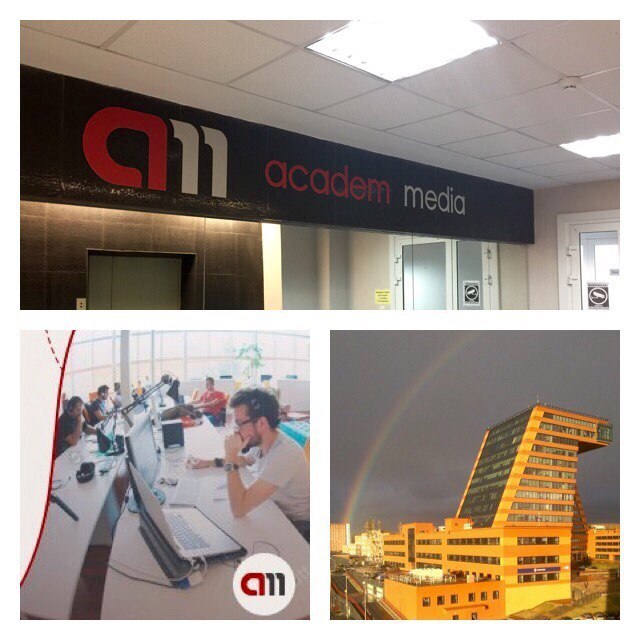
The school that we organized with the company-resident of the Novosibirsk Technopark Academ Media, according to our information, still had no analogues in our region. The fact is that the company's specialists conducted free two-month classes in several specific areas at once:
The specificity of the company is the maximum orientation to work with the Apple App Store and the Mac Store, in connection with which the classrooms organized in the company's offices were equipped with apple technology so that students immediately get used to working with them.
Realizing that the courses will be primarily of interest to very young specialists and students of the last courses, when recruiting students for courses, HR specialists from Academ Media were guided precisely by this target audience.
Today we will tell you how classes were held in the 3 most sought-after areas of the course: mobile application marketing, Unity mobile games development, and interface design and design.
The number of vacancies was limited: it was planned to recruit 4 employees in the marketing department, 3 in the design UI department, and 4 in the development department.
Classes, of course, were conducted for a significantly larger number of students. For 2 weeks, during which an active recruitment of participants was conducted, the number of applications exceeded the planned limits several times, despite the fact that the information about the School was distributed only by free methods:
Academ Media office is located in Akademgorodok - the center of science and information technology in Novosibirsk. Despite the fact that Akademgorodok is located within the city, it is 30 km away from the center. Some who wish to take part in the learning process, unfortunately, dropped out for this very reason.
The remaining brave men, who were not frightened by the long road, filled out the questionnaires, were interviewed and began their studies.
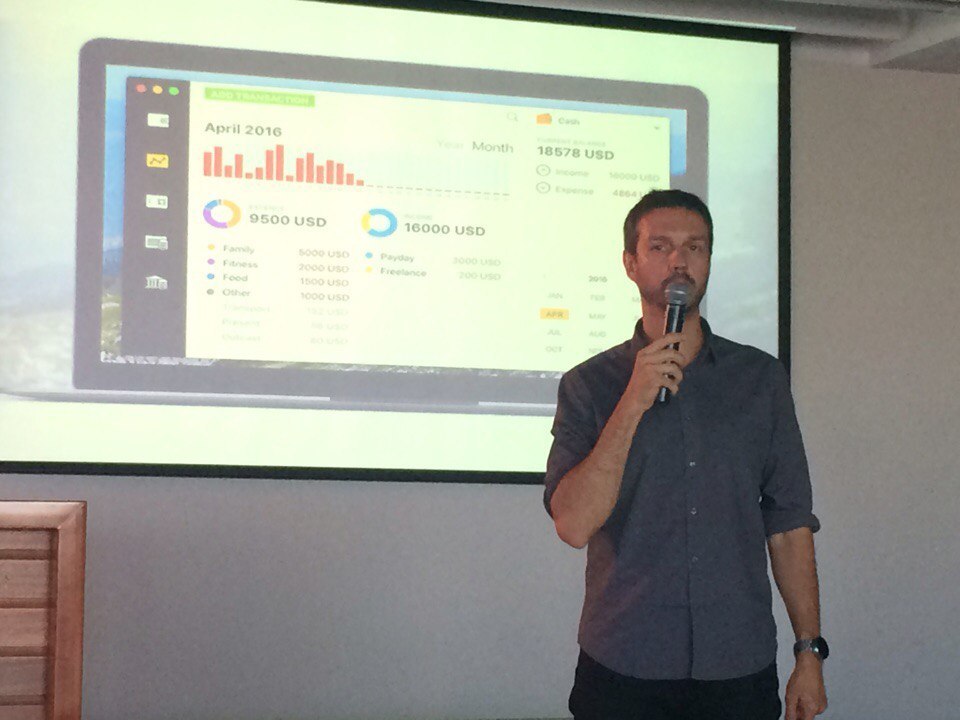
Although when recruiting students, a single goal was pursued, the characteristics of each direction dictated different approaches to the learning process.
Mobile Application Marketing
There was no doubt that this course would be popular: at the moment, preparation for the chosen specialty is not carried out almost anywhere. As far as we know, no university offers the opportunity to specialize in the marketing of mobile applications. Those interested in the topic usually use online materials, such as lectures from the school of Internet marketing company Yandex or blog Oleg Yakubenkova.
This, of course, does not mean that there are no worthy specialists in this area, rather, it is almost impossible to find them - self-taught with a good level have already been set up in top companies, and there are simply no organized sites for beginners. Even in Novosibirsk, the largest megalopolis, the heart of Siberia, events related to the marketing of mobile applications are more like closed parties for professionals. Based on this state of affairs, the organizers decided to fill the lacuna, offering an option for those who have a general idea of the subject and want to undergo specialization.
The course was relatively small for 40 hours, during which students received an idea of marketing as a whole, about the mobile application market and its trends, studied various types of monetization, looked at all sorts of ways to promote and tried to understand the specifics of working with each of them. And most importantly, students of the course were able in practice to get acquainted with the tools necessary for the marketer of mobile applications. These include analytical tools (flurry, mixpanel), tools for a / b-testing (Splitmetrics), as well as tools for selecting keywords (sensortower, appcodes, etc.).
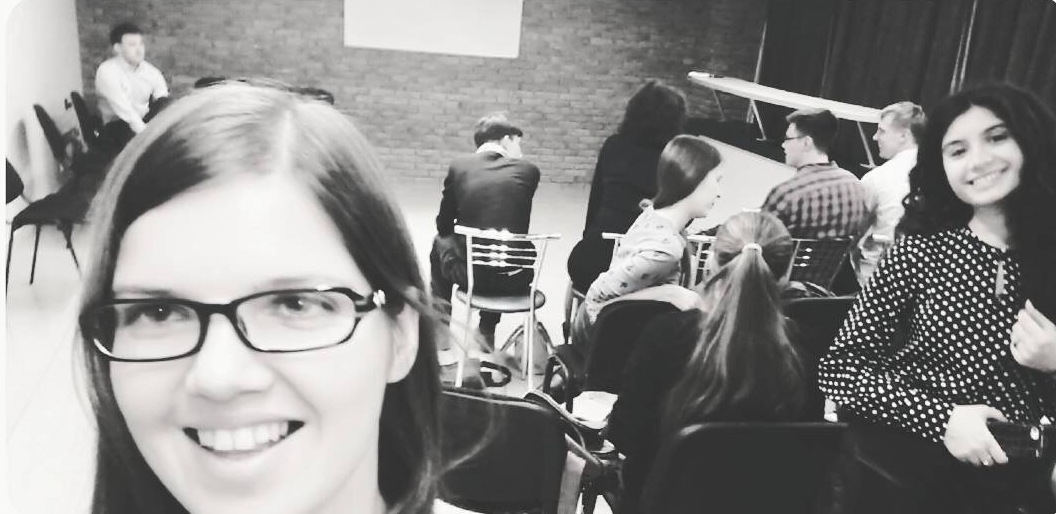
The classes were held twice a week in a mixed format - the lectures alternated with practical tasks and work in groups. It was very important to look at the students “in action”; not only to make sure that they successfully learn the material, but also to evaluate the course of thought as a whole, to give an opportunity to show universal skills - the ability to improvise, a good command of the language, initiative.
Of the 30 people who attended the courses, the curators selected those who are most advanced in understanding this market, and also showed themselves to be purposeful and mobile, and offered them work.

Unity3d
Unity3D schools in Novosibirsk also have not yet appeared, but many students were already familiar with this engine in various top games. When recruiting students for this direction, teachers were primarily interested in students of 4-5 courses of technical specialties, but did not limit their choice to programmers.
Note that the Unity3D course was taught from the point of view of developing 2D games. Mobile game development pampers players with a multitude of three-dimensional worlds for every taste, but 2D games hardly lose their relevance in the foreseeable future, and many successful projects of the company are implemented in 2D. In addition, those basic principles that visitors of the School have studied can be applied without problems regardless of the presence or absence of the axis of applicat in the game.
The program included both elementary aspects of game development (vector algebra, physics in Unity3D, the basics of scripting), and more complex material (path finding algorithms, simple game artificial intelligence). For learning, it was necessary to know at least one (any) object-oriented programming language.
Even before the start of the course, the company's specialists organized several master classes in the universities of the city. During the presentation, emphasis was placed on the importance of the mathematical apparatus in modern and classic games. Examples were selected different: finding the path using the example of PacMan, using vectors when jumping into Mario, sophisticated systems for calculating grenade bounces in Worms or the inverse square root algorithm in Quake 3. The cases caused great interest among students: many played these games, but had no idea how they are arranged and what difficulties the developers faced while creating them. After the master classes, the students surrounded the lecturer with questions, someone even wanted to show their demo work in Unity. This experience finally convinced us that the decision to conduct the School was not made in vain. As one of the organizers put it, he felt like the hero of Minecraft, stumbled upon an ore vein in superplane mode.
About 40 people came to the first meeting, but gradually the number of students decreased by half due to the fact that not all students could physically attend courses 2 times a week and keep up with the program. The classes started very smoothly, but later there were problems associated with different levels of knowledge among students. Someone hurried forward, someone lagged behind, and the organizers had to constantly adjust the course on the go. It was a little exhausting, but it gave the result: over time, the lagging behind began to catch up, and those who ran ahead stopped hurrying and began to work more on the details.
Most students liked the flexibility of the engine. The classic platformer that was on their hands at the beginning of the lesson, by the end could turn into a physical puzzle or 2D shooter. Thus, teachers tried to show that, having such a powerful tool in their hands as Unity, the students were limited only by their imagination. At first, the guys were afraid to experiment and looked at the game with caution (“what if I break something?”). However, they soon began to get used to the idea that as part of the educational process, you can realize anything you want. After graduation, students could take their projects with them, improve and publish them.
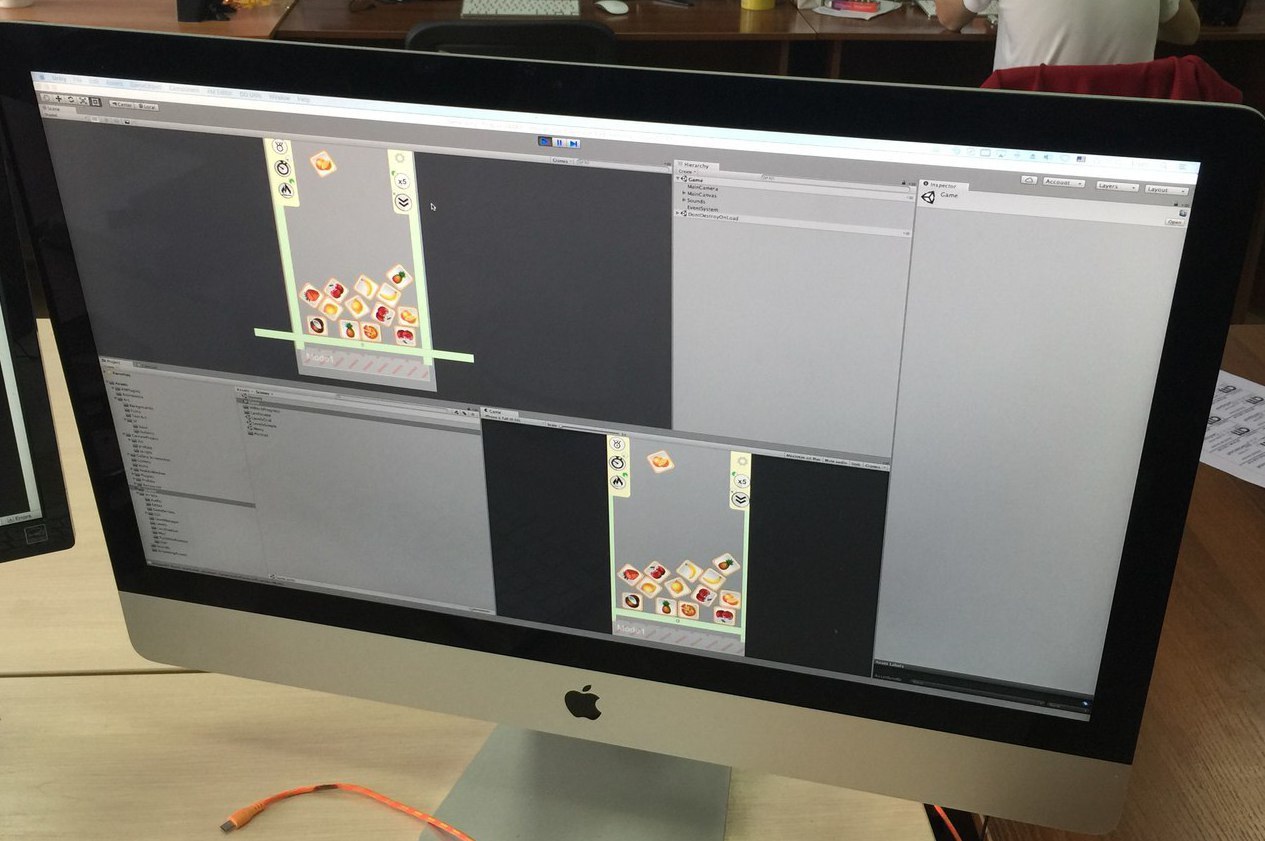
Some topics had to be studied more deeply, and some were absorbed very easily, literally for half a lesson. For example, the sound system in Unity is not complex, especially in 2D games, but the Canvas-based UI required detailed study. Strong emphasis was placed on the work at home, since the material was huge and often the time allotted for the lesson was simply not enough. There were also homework. Many students wrote in Skype, asked for advice and help in decisions, to which the teachers readily responded, since feedback in teaching is especially important.
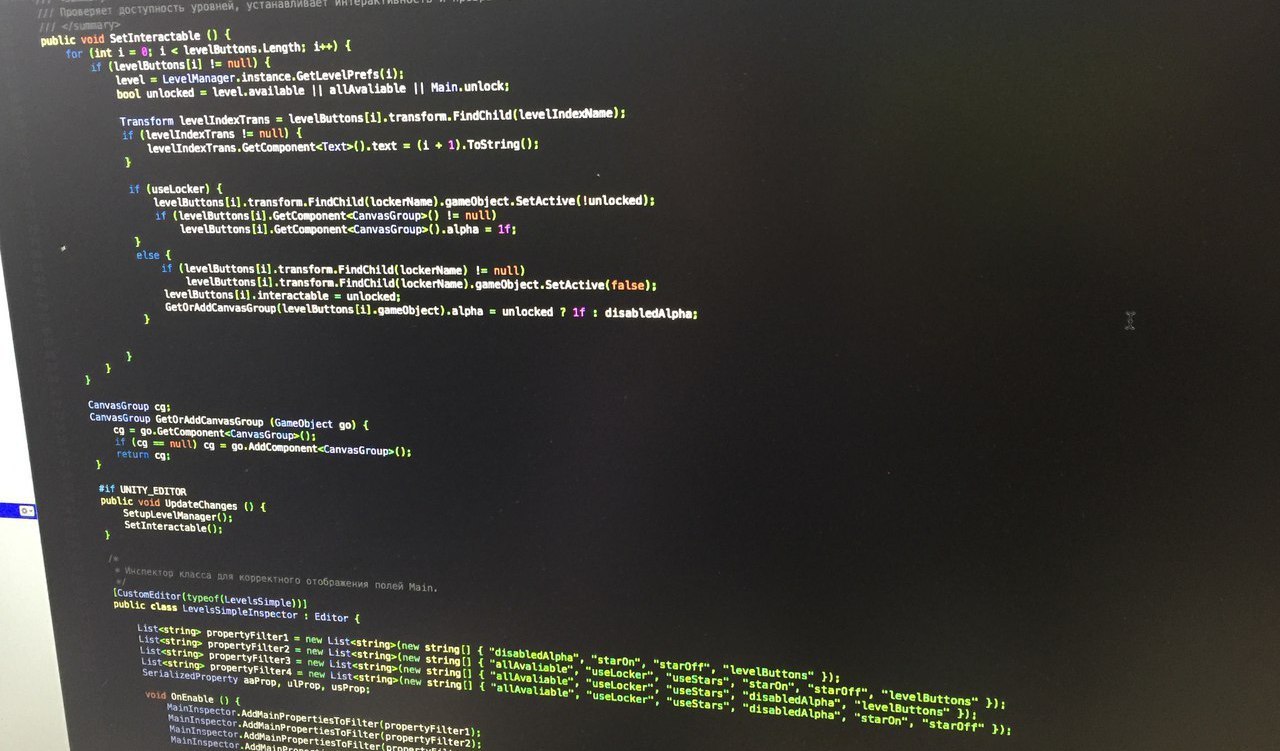
The course curator — the head of the 2D development department, Timofey Netsvetaev — was pleased with the results of this experiment: “We selected the best guys from those who attended the School. They almost immediately came to work for us, and many of them have already stepped out of the junior position further up the career ladder. Those who could not complete their education to the end or did not get a job at the company, still thanked for organizing such activities, which showed them that there was nothing critically difficult to create games and that all problems could be solved. From myself I will add that it was a very interesting experience, since until this point I had never worked with students and I did not have the skill of teaching. At the same time, all the students turned out to be interested in classes and often themselves built a lesson plan based on their tasks. ”
Design and Interface Design
The course of UI-design was the most intensive: classes were held daily from 10:00 to 16:00. Unlike other specialties, where teachers worked with large groups, a more individual approach was practiced here. From the very first lesson, each of the students was assigned a curator from among the team leaders of the design and interface design department of the company, who helped the student deal with the material and answered questions about the project. There were no general lectures, the students were given the opportunity to master the base directly while working on the interface and communicating with the curator.
No one from the set had any experience with the graphic editor Sketch, so there were no problems with different levels of skills at the first stage. Accordingly, the course began with an introduction to Sketch, its tools, features and capabilities, smoothly proceeding to practice - working with simple illustrations with the gradual complication of the task. After that, students were asked to familiarize themselves with Apple, Google and Microsoft guidelines, color guides, illustrations, and fonts. Next, the students created their first simple iOS application interface, which was then required to adapt to Mac, Windows and Android. Having put their hand on the simple, the guys began to work on more complex interface options, also not forgetting to adapt them for various devices, including Apple TV.

By the way, all the stages of work on projects were reflected in the corresponding tasks in the Jira system, which is used in the company. Thus, the students were casually accustomed to the local features of the organization of the workflow.
According to the final results, 3 talented students were selected who received job offers.
In general, the experience was positive and very interesting. Having closed 100% of the task of recruiting new motivated employees who have a clear idea of their tasks in the company, the specialists of Academ Media themselves tried a completely new role. It was extremely nice to see a sincere interest in the learning process. As a result, the new employees were satisfied with the work in the company, and the organizers, in turn, were satisfied with their results. Next autumn they plan to repeat their successful experience.
We hope that our story was useful for you and you may also want to organize something similar in your city. We will be glad if you share your experience of participating or organizing similar events in the comments.
Thanks for attention!
We with our long-time partners and friends - Novosibirsk IT company Academ Media - did not remain aloof from this practice and last autumn organized a similar project within the walls of their company. Why such an experience may be useful and what was taught in the School, we shall understand right now.

')
Each recruitment manager sleeps and sees how motivated and competent job seekers come to him, who will be quite the authorities and who will also easily join the team. In reality, everything is not so rosy. The first impression is often deceptive for both parties, and according to the test task it is impossible to say with certainty how much the skills and experience gained by the new employee earlier will be useful for working in this team with all its specifics. This leads to a speedy and sometimes painful parting, staff turnover and mutual discontent.
With junior business is even more difficult. The test task is weakly correlated with real tasks, the experience of (any) work may be absent as such. Accordingly, the main criteria for selection are the desire to work, learnability and team-oriented.
Thus, although the organization of a school based on a company is a resource-intensive initiative, it helps to solve a number of problems. Before entering into an employment contract, you will get an idea of who you will deal with, and a potential employee in a fairly informal setting will become familiar with the requirements and principles of operation of a particular company. In other words, you want a good employee - learn it yourself.

The school that we organized with the company-resident of the Novosibirsk Technopark Academ Media, according to our information, still had no analogues in our region. The fact is that the company's specialists conducted free two-month classes in several specific areas at once:
- development of mobile games on Unity;
- mobile application marketing;
- 2D graphics for mobile applications;
- design and interface design.
The specificity of the company is the maximum orientation to work with the Apple App Store and the Mac Store, in connection with which the classrooms organized in the company's offices were equipped with apple technology so that students immediately get used to working with them.
How did the recruitment process
Realizing that the courses will be primarily of interest to very young specialists and students of the last courses, when recruiting students for courses, HR specialists from Academ Media were guided precisely by this target audience.
Today we will tell you how classes were held in the 3 most sought-after areas of the course: mobile application marketing, Unity mobile games development, and interface design and design.
The number of vacancies was limited: it was planned to recruit 4 employees in the marketing department, 3 in the design UI department, and 4 in the development department.
Classes, of course, were conducted for a significantly larger number of students. For 2 weeks, during which an active recruitment of participants was conducted, the number of applications exceeded the planned limits several times, despite the fact that the information about the School was distributed only by free methods:
- First of all, a landing page and a group of VKontakte were created;
- The information was posted on local forums;
- Implemented distribution in the community of vk Novosibirsk universities;
- The presentation of the event at the Technopark Open Day was held;
- Leading experts of the company held lectures at universities in Novosibirsk as part of the student conference # konfe_days at NSTU and the Days of Science 2016 event at SibSUTI and at the same time told about upcoming courses.
Academ Media office is located in Akademgorodok - the center of science and information technology in Novosibirsk. Despite the fact that Akademgorodok is located within the city, it is 30 km away from the center. Some who wish to take part in the learning process, unfortunately, dropped out for this very reason.
The remaining brave men, who were not frightened by the long road, filled out the questionnaires, were interviewed and began their studies.

They teach at school, they study at school ...
Although when recruiting students, a single goal was pursued, the characteristics of each direction dictated different approaches to the learning process.
Mobile Application Marketing
There was no doubt that this course would be popular: at the moment, preparation for the chosen specialty is not carried out almost anywhere. As far as we know, no university offers the opportunity to specialize in the marketing of mobile applications. Those interested in the topic usually use online materials, such as lectures from the school of Internet marketing company Yandex or blog Oleg Yakubenkova.
This, of course, does not mean that there are no worthy specialists in this area, rather, it is almost impossible to find them - self-taught with a good level have already been set up in top companies, and there are simply no organized sites for beginners. Even in Novosibirsk, the largest megalopolis, the heart of Siberia, events related to the marketing of mobile applications are more like closed parties for professionals. Based on this state of affairs, the organizers decided to fill the lacuna, offering an option for those who have a general idea of the subject and want to undergo specialization.
The course was relatively small for 40 hours, during which students received an idea of marketing as a whole, about the mobile application market and its trends, studied various types of monetization, looked at all sorts of ways to promote and tried to understand the specifics of working with each of them. And most importantly, students of the course were able in practice to get acquainted with the tools necessary for the marketer of mobile applications. These include analytical tools (flurry, mixpanel), tools for a / b-testing (Splitmetrics), as well as tools for selecting keywords (sensortower, appcodes, etc.).

The classes were held twice a week in a mixed format - the lectures alternated with practical tasks and work in groups. It was very important to look at the students “in action”; not only to make sure that they successfully learn the material, but also to evaluate the course of thought as a whole, to give an opportunity to show universal skills - the ability to improvise, a good command of the language, initiative.
Of the 30 people who attended the courses, the curators selected those who are most advanced in understanding this market, and also showed themselves to be purposeful and mobile, and offered them work.

Unity3d
Unity3D schools in Novosibirsk also have not yet appeared, but many students were already familiar with this engine in various top games. When recruiting students for this direction, teachers were primarily interested in students of 4-5 courses of technical specialties, but did not limit their choice to programmers.
Note that the Unity3D course was taught from the point of view of developing 2D games. Mobile game development pampers players with a multitude of three-dimensional worlds for every taste, but 2D games hardly lose their relevance in the foreseeable future, and many successful projects of the company are implemented in 2D. In addition, those basic principles that visitors of the School have studied can be applied without problems regardless of the presence or absence of the axis of applicat in the game.
The program included both elementary aspects of game development (vector algebra, physics in Unity3D, the basics of scripting), and more complex material (path finding algorithms, simple game artificial intelligence). For learning, it was necessary to know at least one (any) object-oriented programming language.
Even before the start of the course, the company's specialists organized several master classes in the universities of the city. During the presentation, emphasis was placed on the importance of the mathematical apparatus in modern and classic games. Examples were selected different: finding the path using the example of PacMan, using vectors when jumping into Mario, sophisticated systems for calculating grenade bounces in Worms or the inverse square root algorithm in Quake 3. The cases caused great interest among students: many played these games, but had no idea how they are arranged and what difficulties the developers faced while creating them. After the master classes, the students surrounded the lecturer with questions, someone even wanted to show their demo work in Unity. This experience finally convinced us that the decision to conduct the School was not made in vain. As one of the organizers put it, he felt like the hero of Minecraft, stumbled upon an ore vein in superplane mode.
About 40 people came to the first meeting, but gradually the number of students decreased by half due to the fact that not all students could physically attend courses 2 times a week and keep up with the program. The classes started very smoothly, but later there were problems associated with different levels of knowledge among students. Someone hurried forward, someone lagged behind, and the organizers had to constantly adjust the course on the go. It was a little exhausting, but it gave the result: over time, the lagging behind began to catch up, and those who ran ahead stopped hurrying and began to work more on the details.
Most students liked the flexibility of the engine. The classic platformer that was on their hands at the beginning of the lesson, by the end could turn into a physical puzzle or 2D shooter. Thus, teachers tried to show that, having such a powerful tool in their hands as Unity, the students were limited only by their imagination. At first, the guys were afraid to experiment and looked at the game with caution (“what if I break something?”). However, they soon began to get used to the idea that as part of the educational process, you can realize anything you want. After graduation, students could take their projects with them, improve and publish them.

Some topics had to be studied more deeply, and some were absorbed very easily, literally for half a lesson. For example, the sound system in Unity is not complex, especially in 2D games, but the Canvas-based UI required detailed study. Strong emphasis was placed on the work at home, since the material was huge and often the time allotted for the lesson was simply not enough. There were also homework. Many students wrote in Skype, asked for advice and help in decisions, to which the teachers readily responded, since feedback in teaching is especially important.

The course curator — the head of the 2D development department, Timofey Netsvetaev — was pleased with the results of this experiment: “We selected the best guys from those who attended the School. They almost immediately came to work for us, and many of them have already stepped out of the junior position further up the career ladder. Those who could not complete their education to the end or did not get a job at the company, still thanked for organizing such activities, which showed them that there was nothing critically difficult to create games and that all problems could be solved. From myself I will add that it was a very interesting experience, since until this point I had never worked with students and I did not have the skill of teaching. At the same time, all the students turned out to be interested in classes and often themselves built a lesson plan based on their tasks. ”
Design and Interface Design
The course of UI-design was the most intensive: classes were held daily from 10:00 to 16:00. Unlike other specialties, where teachers worked with large groups, a more individual approach was practiced here. From the very first lesson, each of the students was assigned a curator from among the team leaders of the design and interface design department of the company, who helped the student deal with the material and answered questions about the project. There were no general lectures, the students were given the opportunity to master the base directly while working on the interface and communicating with the curator.
No one from the set had any experience with the graphic editor Sketch, so there were no problems with different levels of skills at the first stage. Accordingly, the course began with an introduction to Sketch, its tools, features and capabilities, smoothly proceeding to practice - working with simple illustrations with the gradual complication of the task. After that, students were asked to familiarize themselves with Apple, Google and Microsoft guidelines, color guides, illustrations, and fonts. Next, the students created their first simple iOS application interface, which was then required to adapt to Mac, Windows and Android. Having put their hand on the simple, the guys began to work on more complex interface options, also not forgetting to adapt them for various devices, including Apple TV.

By the way, all the stages of work on projects were reflected in the corresponding tasks in the Jira system, which is used in the company. Thus, the students were casually accustomed to the local features of the organization of the workflow.
According to the final results, 3 talented students were selected who received job offers.
findings
In general, the experience was positive and very interesting. Having closed 100% of the task of recruiting new motivated employees who have a clear idea of their tasks in the company, the specialists of Academ Media themselves tried a completely new role. It was extremely nice to see a sincere interest in the learning process. As a result, the new employees were satisfied with the work in the company, and the organizers, in turn, were satisfied with their results. Next autumn they plan to repeat their successful experience.
We hope that our story was useful for you and you may also want to organize something similar in your city. We will be glad if you share your experience of participating or organizing similar events in the comments.
Thanks for attention!
Source: https://habr.com/ru/post/321412/
All Articles